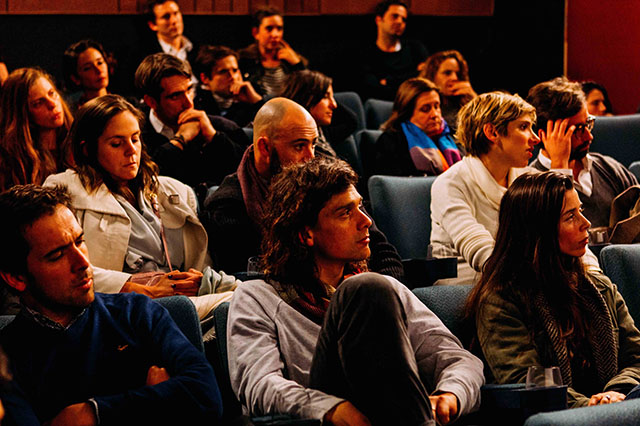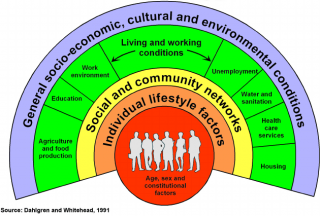
www.buildingsandcities.org/insights/commentaries/scientific-conferences-and-the-pandemic.html
Scientific Conferences and the Pandemic

The present format of scientific conferences is outdated and needs to rapidly change. How we can reconfigure conferences to better suit the needs of researchers?
The COVID-19 outbreak has cancelled or postponed conferences, shifting others to virtual meetings. This presents an opportunity to reflect on the questions about the purpose of scientific conferences and ways to improve them: how can they function more effectively, how are they organised, who are the major beneficiaries, should their number be reduced, and how to limit their environmental impacts (especially from air travel)? Buildings & Cities' Richard Lorch argues for the urgent need to change scientific conferences.
The first and foremost purpose of conferences is the sharing of new information and research in progress. This is coupled with the need for formal and informal feedback. Another is the networking function, for new collaborative ventures and career development. A third reason is to satisfy institutional metrics of productivity. Conference presentations and proceedings currently tick an important box for career advancement. An additional benefit of conferences is the creation of a 'community of practice' (Wenger, 1998) for researchers working on particular questions and issues, and thereby helping to establish goals and future research agendas.
As well as the obvious benefits of conferences, there are also many hidden disbenefits. This system often excludes researchers whose institutions cannot fund their conference participation and this disproportionately affects those from poorer countries. Conferences can also be an inefficient use of researchers' personal time and resources: a three-day conference can take a working week (including travel) to deliver a 20-minute presentation with a bit of networking. The feedback given to presenters is often inadequate and disappointing. Several factors inhibit in-depth discussions and detailed feedback, e.g. limitations of tight timeframes, large audiences, multiple session tracks, etc. Then there are the hidden environmental costs which are exacerbating the climate emergency.
The climate implications of physical conferences are a paramount issue. Business as usual for these conferences is no longer an option. The science is clear on the urgent need to radically reduce our collective and individual carbon footprints in order to contain global warming to 2 °C or below (IPCC, 2018). The case for not flying and reducing travel altogether is both compelling and necessary. The irony of flying to a conference to deliver a paper on reducing carbon emissions must stop. New and better models exist for the academic community to network and exchange knowledge.
Over the past 2 generations, the number of research conferences in every discipline has multiplied as a response to many different institutional and funding drivers. Some conferences have become a profitable business, although many just cover their costs. However, the venues, hotels, local municipalities and others profit from hosting conferences. The economics of covering these substantial costs act as drivers for making conferences ever larger. The result is the creation of large conferences with many isolated parallel sessions and the need for commercial sponsorship. Conference organisers can find themselves pressured to accept poor abstracts / papers in order to ensure a viable number of delegates. As presenting a poster is often insufficient for delegates to secure funding, some conference organisers have lowered their criteria for acceptance of oral presentations and papers. A positive consequence is this may help to widen the community. On the other hand, conference delegates may find the weak content to be tedious and a waste of time. More fundamental issues about the role and quality of conferences must be addressed.
Conferences reinforce a misplaced notion of productivity in the knowledge economy. An individual's number of presentations is a poor indicator of intellectual productivity and should not be used in decisions assessing career achievement. Quality is much more important than quantity. Less value should be assigned to grey literature and grey presentations.
Virtual conferences?
In the short term, moving conferences to a digital platform will help to overcome the restrictions imposed by the COVID-19 outbreak. It can allow researchers to present their work, publish their work in proceedings or hear keynote presentations. However, virtual conferences are not a universal panacea over the longer term.
It would be a mistake to make digital technologies follow the same formats as physical events. Creative thinking is needed to harness the variety of virtual modes for particular purposes, needs and audiences - a non-trivial task to reinvent how we do things. Talks can be curated, edited and packaged in new ways. Presenters could create and refine their draft presentations ensure the key message is conveyed clearly and succinctly. Scientific committees could be asked to comment on presentations submitted in advance: those digitally recorded as well as written papers. Improved processes of moderation can provide richer feedback / discussion to presenters. The frustration involving parallel sessions at physical events (the desire to hear two or more things scheduled at the same time) can be avoided.
The health consequences of moving to digital formats presents new challenges. It can be exhausting for delegates to be in front of a screen for extended periods of time. Care needs to be taken to changing the format, timetable and organisation of a virtual conference to accommodate participants' psychological needs and work pattern.
The discovery of relevant content will become much easier and become accessible to larger online audiences over a much longer period of time. Thought needs to be given to the intellectual property rights and uses of conference presentations that are posted online - particularly to protect research in progress.
Other opportunities also exist for academic discussion. The role of research journals is evolving. In addition to peer-reviewed articles, the Buildings & Cities website was designed to encourage exchange of information, feedback and outreach in a variety of ways:
- news about the research community
- commentaries shaping the research agenda
- feedback on published articles
- reviews of books and conferences
- briefings on particular topics
- virtual discussions of special issues
The B&C website is evolving further and we intend to host other media in the coming months.
It's time to ask some fundamental questions, to consider the underpinning concepts and practices surrounding conferences and to seek better ways of doing. Key questions for discussion are:
- Do the regimes governing the academic community place too much emphasis on conference presentations as a means of dissemination? Is this an appropriate metric for productivity? Is there too much funding for attending conferences? Could this funding be deployed in better ways?
- Are there too many conferences? What benefits and problems arise from scaling back the number or frequency of conferences with regard to ensuring the quality of knowledge exchange and feedback?
- Are there better ways to share knowledge and information? Can virtual or hybrid virtual/physical conferences provide better solutions?
- Are conferences efficient use of participants' time? Should less time be spent attending conferences?
- Can scientific conferences be made less disruptive for people who are caregivers?
- How can alternative and virtual scientific exchanges be made more inclusive?
- Can the inclusivity of scientific exchange be improved?
- How can the carbon footprints and environmental impacts of conferences (especially travel) be radically reduced?
- Is the typical passive powerpoint presentation the best way to convey research? What alternative formats are needed to make engagement more dynamic?
- Is the quality of formal and informal feedback given to researchers at conferences adequate? Can it be improved?
- Can informal and random networking occur in virtual realms?
- What is the best size for a networking event, such as a virtual conference?
Sustainability has taught us that escalation in scale can lead to negative impacts. Going forward, fewer research conferences will be a wise approach and promote a focus on quality. In the first instance, this could be comprised of a strategy that alternates between physical and virtual events. Digital events offer several opportunities for a group to meet for a shorter period of time and require less funding for doing so. It is possible to become less dependent on travel for face-to-face meetings and conferences.
References
IPCC - The Intergovernmental Panel on Climate Change. (2018). Global Warming of 1.5°C. An IPCC Special Report on the impacts of global warming of 1.5°C above pre-industrial levels and related global greenhouse gas emission pathways, in the context of strengthening the global response to the threat of climate change, sustainable development, and efforts to eradicate poverty. Geneva: World Meteorological Organization. https://www.ipcc.ch/sr15/
Wenger, E. (1998). Communities of Practice: Learning, Meaning, and Identity. New York: Cambridge University Press.
Latest Peer-Reviewed Journal Content
Youth engagement in urban living labs: tools, methods and pedagogies
N Charalambous, C Panayi, C Mady, T Augustinčić & D Berc
Co-creating urban transformation: a stakeholder analysis for Germany’s heat transition
P Heger, C Bieber, M Hendawy & A Shooshtari
Placemaking living lab: creating resilient social and spatial infrastructures
M Dodd, N Madabhushi & R Lees
Church pipe organs: historical tuning records as indoor environmental evidence
B Bingley, A Knight & Y Xing
A framework for 1.5°C-aligned GHG budgets in architecture
G Betti, I Spaar, D Bachmann, A Jerosch-Herold, E Kühner, R Yang, K Avhad & S Sinning
Net zero retrofit of the building stock [editorial]
D Godoy-Shimizu & P Steadman
Co-learning in living labs: nurturing civic agency and resilience
A Belfield
The importance of multi-roles and code-switching in living labs
H Noller & A Tarik
Researchers’ shifting roles in living labs for knowledge co-production
C-C Dobre & G Faldi
Increasing civic resilience in urban living labs: city authorities’ roles
E Alatalo, M Laine & M Kyrönviita
Co-curation as civic practice in community engagement
Z Li, M Sunikka-Blank, R Purohit & F Samuel
Preserving buildings: emission reductions from circular economy strategies in Austria
N Alaux, V Kulmer, J Vogel & A Passer
Urban living labs: relationality between institutions and local circularity
P Palo, M Adelfio, J Lundin & E Brandão
Living labs: epistemic modelling, temporariness and land value
J Clossick, T Khonsari & U Steven
Co-creating interventions to prevent mosquito-borne disease transmission in hospitals
O Sloan Wood, E Lupenza, D M Agnello, J B Knudsen, M Msellem, K L Schiøler & F Saleh
Circularity at the neighbourhood scale: co-creative living lab lessons
J Honsa, A Versele, T Van de Kerckhove & C Piccardo
Positive energy districts and energy communities: how living labs create value
E Malakhatka, O Shafqat, A Sandoff & L Thuvander
Built environment governance and professionalism: the end of laissez-faire (again)
S Foxell
Co-creating justice in housing energy transitions through energy living labs
D Ricci, C Leiwakabessy, S van Wieringen, P de Koning & T Konstantinou
HVAC characterisation of existing Canadian buildings for decarbonisation retrofit identification
J Adebisi & J J McArthur
Simulation and the building performance gap [editorial]
M Donn
Developing criteria for effective building-sector commitments in nationally determined contributions
P Graham, K McFarlane & M Taheri
Join Our Community

The most important part of any journal is our people – readers, authors, reviewers, editorial board members and editors. You are cordially invited to join our community by joining our mailing list. We send out occasional emails about the journal – calls for papers, special issues, events and more.
We will not share your email with third parties. Read more



Latest Commentaries
COP30 Report
Matti Kuittinen (Aalto University) reflects on his experience of attending the 2025 UN Conference of the Parties in Belém, Brazil. The roadmaps and commitments failed to deliver the objectives of the 2025 Paris Agreement. However, 2 countries - Japan and Senegal - announced they are creating roadmaps to decarbonise their buildings. An international group of government ministers put housing on the agenda - specifying the need for reduced carbon and energy use along with affordability, quality and climate resilience.
Building-Related Research: New Context, New Challenges
Raymond J. Cole (University of British Columbia) reflects on the key challenges raised in the 34 commissioned essays for Buildings & Cities 5th anniversary. Not only are key research issues identified, but the consequences of changing contexts for conducting research and tailoring its influence on society are highlighted as key areas of action.